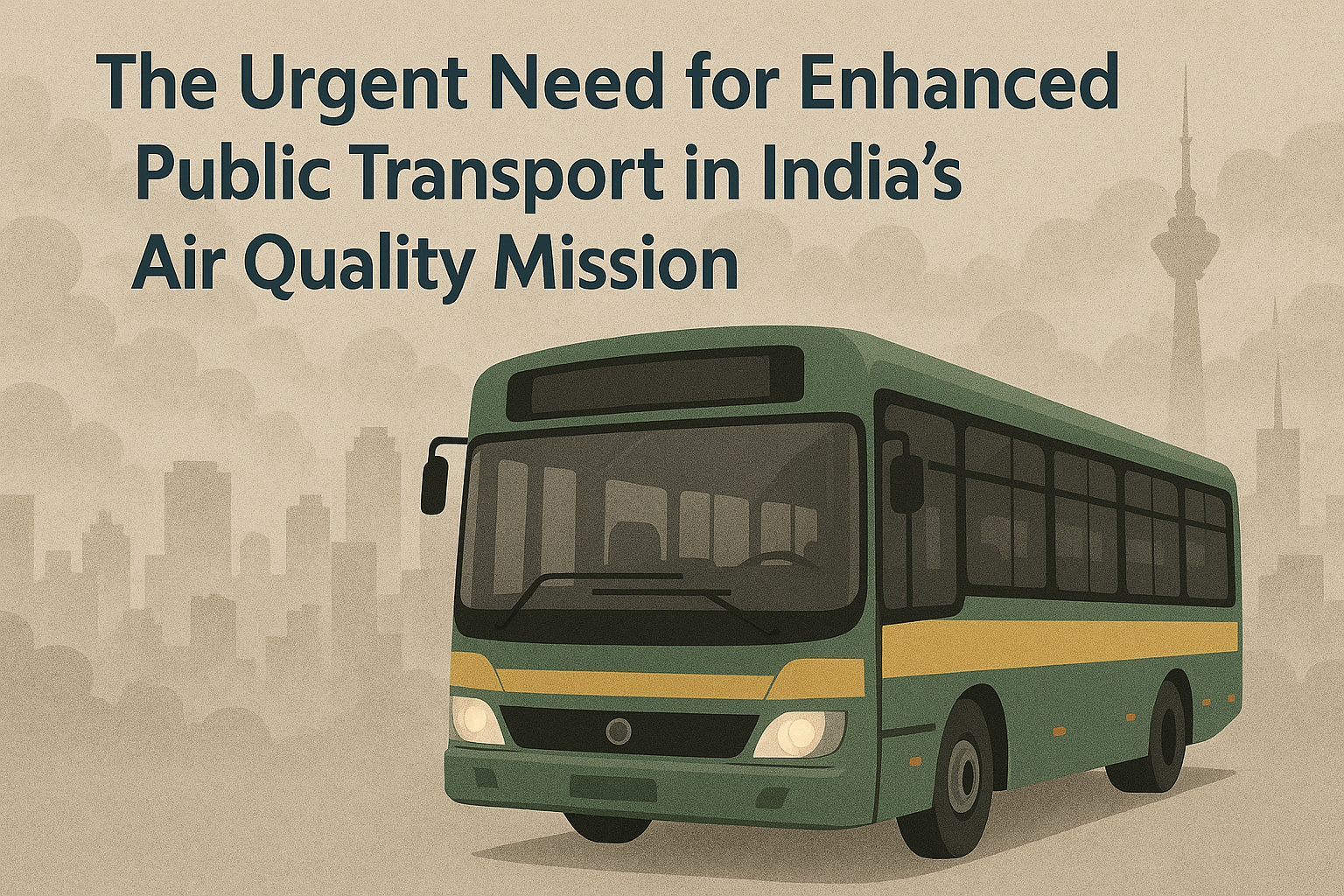A cornerstone of the National Clean Air Program (NCAP) is that it prioritizes micro-level interventions like improving urban infrastructure, monitoring networks, and sustainable practices. The XIV Finance Commission allocated ₹36,000 crores to support city specific action plans tailored to their challenges. Despite this funding, achieving NCAP’s ambitious targets necessitates tackling a major source to urban air pollution- Road Transport.

Road transport, accounting for 20-30% of PM2.5 and PM10 concentrations (IEA, 2023) in India, is a major contributor to urban air pollution, facilitating 90% of passenger and 70% of freight movement (TERI, 2021). Delhi’s vehicular emissions contribute 24% of PM10 and 28% of PM2.5 levels in winter, and 15% of PM10 and 17% of PM2.5 in summer. Cities like Bengaluru, Jaipur, Kanpur, and Surat also show significant seasonal variability, stressing the need to mitigate road transport emissions, which is crucial for improving urban air quality and achieving NCAP targets. Expanding sustainable, low-emission public transport reduces dependency on private vehicles, a key contributor to pollution, thereby curbing emissions and promoting cleaner, healthier urban environments.
Gaps in the Public Transport Systems
Public Transport (PT) analysis in NACs reveals glaring deficiencies, with most cities relying on city buses and Intermediate Public Transport (IPT) for mass transit. Metro and RRTS are limited to metro or mega cities, where issues like limited routes, low frequency, and poor connectivity persist. Consequently, these cities operate at suboptimal Level of Service (LOS), falling below MoHUA benchmarks. The LOS analysis, based on buses per 1000 population, highlights that 24 NACs operate at LOS-IV and 38 at LOS-III, emphasizing the need for fleet expansion, improved PT availability and optimized operational models to boost efficiency and accessibility. Cities with populations ranging 2-10 lakhs, like Nagaon, Nalbari, Gaya, Bareilly, etc. require robust, integrated transit networks. Smaller cities under 2 lakhs, like Khurja, Angul, and Srikakulam, need better network expansions and access. Metro and mega cities, including Lucknow, Varanasi, Mumbai, Nagpur, etc., demand improved transit planning, operational frequency and connectivity.
Cities with higher LOS, like Delhi, Bangalore, and Pune, demonstrate the benefits of multimodal planning. Smaller cities with LOS-I, like Kohima, Nalgonda, Baddi etc., require improved transport integration due to lower population density and smaller fleets. To improve LOS across 131 NACs, an estimated 15,289 additional buses are required to foster public transport growth, efficiency, and accessibility.
Funding: Challenges and Strategic Alignment
Deploying 15,289 buses would cost ₹6,116 crore (capital) and ₹8,929 crore (annual operational) for BS-VI buses, versus ₹15,289 crore (capital) and ₹6,697 crore (annual operational) for e-buses. Although BS-VI buses incur low upfront cost, they have higher operational costs and emit pollutants like PM, NOx, and CO2. However, EVs produce zero tailpipe emissions and, when powered by renewable energy, contribute to long-term air quality improvement. Transitioning to electric buses is a more strategic and sustainable choice, despite higher upfront costs, supporting NCAP’s goals and ensuring cleaner urban environment with greater operational efficiency.
Bridging these gaps requires significant funding, with bus costs posing financial challenges. While ₹36,000 crore allocated under NCAP is substantial, it is insufficient for strengthening public transport in NACs alone, as it also funds other sectoral initiatives. This requires pooling NCAP funds with other national schemes to create a unified investment strategy for large-scale infrastructure, prioritizing high-impact urban centres.
Strategic Integration of NCAP with Existing Schemes and Policies
The NCAP can amplify its impact by aligning with initiatives like NUTP, FAME, PM E-Bus Sewa, and PM E-Drive schemes while targeting cities with severe air pollution. FAME’s focus on accelerating EV adoption complements NCAP’s emission-reduction goals. While FAME II ended in March 2024, discussions for FAME III are underway, with proposed ₹2,671 crore interim budget for FY 2024–25, ensuring continued support for EV adoption.
The PM e-Bus Sewa scheme (2023) focuses on deploying electric buses in smaller cities with inadequate PT to reduce emissions, while the PM e-Drive scheme (2024) incentivizes EVs for private and commercial use, promoting EV penetration across multiple sectors. This unified funding approach enables coordinated projects that reduces dependency on private vehicles, reduces emissions, enhance mobility and improves infrastructure.
Targeted solutions for Large and Small Cities
The NCAP funds can support expanding metro, RRTS, and bus networks in larger NACs, while applying Transit-Oriented Development (TOD) principles to create walkable neighbourhoods around transit hubs, reducing car dependency and emissions. For cities with low population density, shared mobility options like e-autos and Demand-Responsive Transit (DRT), offering cost-effective shuttle services where large-scale infrastructure isn’t viable should be promoted. The TOD principles can further improve last-mile connectivity, reduce emissions, enhance urban air quality and transport efficiency.
Developing EV Charging Infrastructure
Developing EV charging infrastructure is vital to accommodate the additional demand of 15,298 e-buses needed in NACs. Strategically located stations near transit hubs and depots will ensure efficient operations, minimize downtime, and optimize efficiency. Integrating renewable energy further reduces emissions, aligning with NCAP's air quality goals.
For cities (population under 10 lakhs) and high PM2.5 and NOx levels, NCAP funding can prioritize smaller, shared EV fleets as cost-effective alternatives to metros or BRTS (relying on high urban densities for economic viability), aiding in emission reduction.
Alignment with Smart Cities Mission
The cities can invest in integrating transit apps offering real-time bus schedules, EV charging locations, and shared mobility services, improving convenience. Further, air quality monitoring on major corridors can drive data-driven decisions in high emission zones, aligning with Smart Cities Mission goals.
Capacity Utilization Planning
Cities with LOS I and II should conduct studies on capacity utilization, route optimization, and frequency adjustments to identify strategies to boost ridership and system performance. For instance, WRI studies highlight low bus occupancy in Delhi due to competition from informal transport, while Bengaluru's BMTC faces inefficiencies during non-peak hours, as noted by CAG and Janaagraha, indicating a need for better scheduling. In contrast, Ahmedabad's BRTS has increased ridership with dedicated corridors, demonstrating how smart planning and integration can optimize bus systems.
Achieving NCAP’s air quality goals requires prioritizing public transport reforms. By Investing in cleaner, efficient transit solutions and integrating it with urban policies can transform Indian cities into sustainable mobility models for a greener future.

